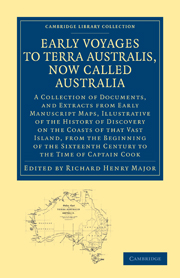 Early Voyages to Terra Australis, Now Called Australia
Early Voyages to Terra Australis, Now Called Australia Book contents
- Frontmatter
- Contents
- INSTRUCTIONS TO THE BINDER
- INTRODUCTION
- A MEMORIAL ADDRESSED TO HIS CATHOLIC MAJESTY PHILIP THE THIRD, KING OF SPAIN
- RELATION OF LUIS VAEZ DE TORRES
- EXTRACT FROM THE BOOK OF DISPATCHES FROM BATAVIA
- THE VOYAGE AND SHIPWRECK OF CAPTAIN FRANCIS PELSART
- VOYAGE OF GERRIT THOMASZ POOL TO THE SOUTH LAND
- ACCOUNT OF THE WRECK OF THE SHIP “DE VERGULDE DRAECK”
- DESCRIPTION OF THE WEST COAST OF THE SOUTH LAND
- EXTRACT TRANSLATED FROM BURGOMASTER WITSEN'S
- ACCOUNT OF THE OBSERVATIONS OF CAPTAIN WILLIAM DAMPIER
- EXTRACT FROM SLOAN MS., 3236
- SOME PARTICULARS RELATING TO THE VOYAGE OF WILLEM DE VLAMINGH
- EXTRACT FROM THE JOURNAL OF A VOYAGE MADE TO THE UNEXPLORED SOUTH LAND
- ACCOUNT OF THE OBSERVATIONS OF CAPTAIN WILLIAM DAMPIER
- A WRITTEN DETAIL OF THE DISCOVERIES AND NOTICEABLE OCCURRENCES
- THE HOUTMAN'S ABROLHOS
- INDEX
- Outline Chart of TERRA AUSTRALIS OF AUSTRALIA
- Plate section
EXTRACT FROM THE JOURNAL OF A VOYAGE MADE TO THE UNEXPLORED SOUTH LAND
Published online by Cambridge University Press: 05 February 2013
- Frontmatter
- Contents
- INSTRUCTIONS TO THE BINDER
- INTRODUCTION
- A MEMORIAL ADDRESSED TO HIS CATHOLIC MAJESTY PHILIP THE THIRD, KING OF SPAIN
- RELATION OF LUIS VAEZ DE TORRES
- EXTRACT FROM THE BOOK OF DISPATCHES FROM BATAVIA
- THE VOYAGE AND SHIPWRECK OF CAPTAIN FRANCIS PELSART
- VOYAGE OF GERRIT THOMASZ POOL TO THE SOUTH LAND
- ACCOUNT OF THE WRECK OF THE SHIP “DE VERGULDE DRAECK”
- DESCRIPTION OF THE WEST COAST OF THE SOUTH LAND
- EXTRACT TRANSLATED FROM BURGOMASTER WITSEN'S
- ACCOUNT OF THE OBSERVATIONS OF CAPTAIN WILLIAM DAMPIER
- EXTRACT FROM SLOAN MS., 3236
- SOME PARTICULARS RELATING TO THE VOYAGE OF WILLEM DE VLAMINGH
- EXTRACT FROM THE JOURNAL OF A VOYAGE MADE TO THE UNEXPLORED SOUTH LAND
- ACCOUNT OF THE OBSERVATIONS OF CAPTAIN WILLIAM DAMPIER
- A WRITTEN DETAIL OF THE DISCOVERIES AND NOTICEABLE OCCURRENCES
- THE HOUTMAN'S ABROLHOS
- INDEX
- Outline Chart of TERRA AUSTRALIS OF AUSTRALIA
- Plate section
Summary
On the morning of the 29th December (1696) at half-past two o'clock, we discovered the South Land, to east northeast of us at from four to five miles distance. We found the country low, the main coast stretching from south to north. Our people observed a remarkable fish here, about two feet long, with a round head and a sort of arms and legs and even something like hands. They found also several stems of plants. They cast anchor in from fourteen to fifteen fathoms. At nearly half a league from the island on the south side they had good holding ground. The wind south-west by south.
On the 30th December we took counsel, and then with our guns on our arms put the shallop afloat and with the chief pilot I went on shore to look round the island. We rowed round to the east corner of the island about a cannon shot distance from the coast, and found there two fathoms water with muddy bottom, filled with shells, and occasionally a sandy bottom. Proceeding a little further, we sounded the little island bearing to the south of us, and the western most point of the large one bearing north-west of us; and we found five fathoms, and good and bad bottom by turns. We afterwards sounded north, the westernmost point bearing N. W. and by W. of us, and the little island S. W., and had as before five fathoms.
- Type
- Chapter
- Information
- Early Voyages to Terra Australis, Now Called AustraliaA Collection of Documents, and Extracts from Early Manuscript Maps, Illustrative of the History of Discovery on the Coasts of that Vast Island, from the Beginning of the Sixteenth Century, pp. 120 - 133Publisher: Cambridge University PressPrint publication year: 2010First published in: 1859


